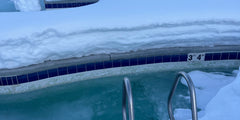
I, like a lot of people, have jumped on the cold plunge / sauna train in recent years. From a survival aspect, training your body to handle stress, and extreme temperatures, can be a very important skill to hold in certain situations. But is it just a fun instagramable moment or are the health benefits really that profound? I did some digging and here’s what my research has uncovered:
SUANA: Studies have shown that regular sauna use can lower blood pressure, improve blood vessel function, and reduce the risk of heart disease. Additionally, saunas may also help to lower the risk of stroke and other cardiovascular events. Here’s how I understand it:
When exposed to high heat (I tend to do 25-30 minutes at around 170 degrees), your body is under stress. Stress elevates your heart rate in much the same way cardiovascular exercise does. In my experience, I go from my resting heart rate of around 38bpm to 80-90bpm when in the sauna. This is basically the equivalent HR when jogging a 9 min mile. Stay in the sauna for 27 minutes and you’ve had the cardio equivalent of running 3 miles with zero stress on your knees and hips.
But there’s a lot more going on here. Heat Shock Proteins are another benefit of Sauna use. Heat stress promotes increased expression of heat shock proteins which prevent protein disorder and aggregation by repairing proteins that have been damaged, providing protection against many chronic diseases and reducing inflammation.
Not convinced yet? How about better skin?
The heat and humidity of a sauna can help to open up the pores, allowing impurities to be released from the skin, increase collagen production, and elasticity of the skin.
WHAT HAPPENS WHEN YOU ADD COLD?
Adding a cold plunge, or a quick dip in cold water, after a sauna session can potentially increase the benefits of sauna usage.
One benefit of a cold plunge is that it increases circulation, strengthening the cardiovascular system. The contrast of hot and cold temperatures in sauna and cold plunge can also help to reduce inflammation and improve overall cardiovascular function.
In addition, a cold plunge can also help to improve the body's resilience to stress. The sudden change in temperature can help to stimulate the release of norepinephrine, a hormone that plays a role in the body's stress response. This can help to improve overall mental and emotional well-being. This, for me, has been one of the biggest effects. My first few times doing a cold plunge, it was very difficult to focus, to calm my breathing, and to stay in the water. But as I’ve done more and more, it becomes more manageable, and frankly feels like I’ve developed more control over my body when it wants to involuntarily react.
CONCLUSION
It goes without saying that I have to recommend you consult your doctor before starting any sauna or cold plunge use. If you get the OK, I recommend starting with 15 minutes in the sauna, followed by 30-45 seconds in the cold plunge. Rotating back and forth is a great way to build up to longer durations, with the ultimate goal of 30 minutes in the sauna and 2-3 minutes in a cold plunge.




